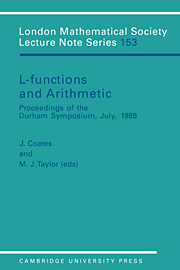Book contents
- Frontmatter
- Contents
- Preface
- Participants
- Lectures on automorphic L-functions
- Gauss sums and local constants for GL(N)
- L-functions and Galois modules
- Motivic p-adic L-functions
- The Beilinson conjectures
- Iwasawa theory for motives
- Kolyvagin's work for modular elliptic curves
- Index theory, potential theory, and the Riemann hypothesis
- Katz p-adic L-functions, congruence modules and deformation of Galois representations
- Kolyvagin's work on Shafarevich-Tate groups
- Arithmetic of diagonal quartic surfaces I
- On certain Artin L-Series
- The one-variable main conjecture for elliptic curves with complex multiplication
- Remarks on special values of L-functions
Index theory, potential theory, and the Riemann hypothesis
Published online by Cambridge University Press: 18 December 2009
- Frontmatter
- Contents
- Preface
- Participants
- Lectures on automorphic L-functions
- Gauss sums and local constants for GL(N)
- L-functions and Galois modules
- Motivic p-adic L-functions
- The Beilinson conjectures
- Iwasawa theory for motives
- Kolyvagin's work for modular elliptic curves
- Index theory, potential theory, and the Riemann hypothesis
- Katz p-adic L-functions, congruence modules and deformation of Galois representations
- Kolyvagin's work on Shafarevich-Tate groups
- Arithmetic of diagonal quartic surfaces I
- On certain Artin L-Series
- The one-variable main conjecture for elliptic curves with complex multiplication
- Remarks on special values of L-functions
Summary
In this survey we would like to paint, in expressionistic brushstrokes, our hunch concerning the problem of the Riemann hypothesis. Langlands said it best [38]: ‘… I have exceeded my commission and been seduced into describing things as they may be and, as seems to me at present, are likely to be. They could be otherwise. Nonetheless, it is useful to have a conception of the whole to which one can refer during the daily, close work with technical difficulties, provided one does not become too attached to it … I have simply fused my own observations and reflections with ideas of others and with commonly accepted tenets’.
Let us begin by recalling the well known analogies between number fields and function fields. For function fields the Riemann hypothesis was solved by Weil, over a finite field [49], and by Selberg, over the complex numbers [43]. Most attempts to date in solving the Riemann hypothesis for number fields follow Hilbert's old suggestion: find an operator, A, acting on a Hilbert space such that 〈Ax, y〉 + 〈x, Ay〉 = 〈x, y〉, and such that is self adjoint, and identify its eigenvalues with the zeros of the zeta function. This approach received scrutiny [22; 25], especially after the success of Selberg's theory, where such an operator, the Laplacian, does in fact exists.
- Type
- Chapter
- Information
- L-Functions and Arithmetic , pp. 257 - 270Publisher: Cambridge University PressPrint publication year: 1991
- 1
- Cited by



